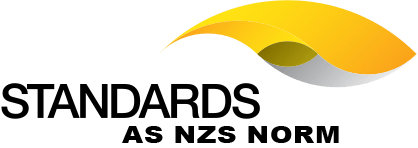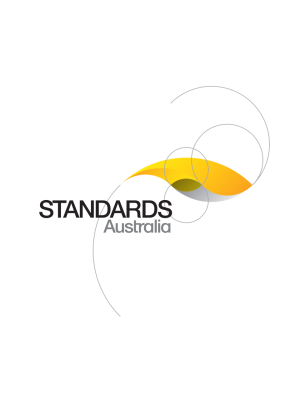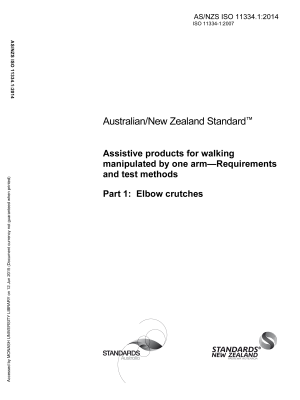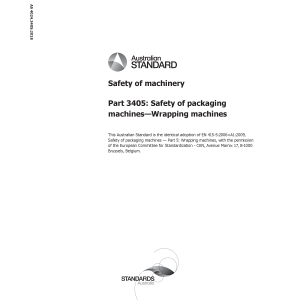🔍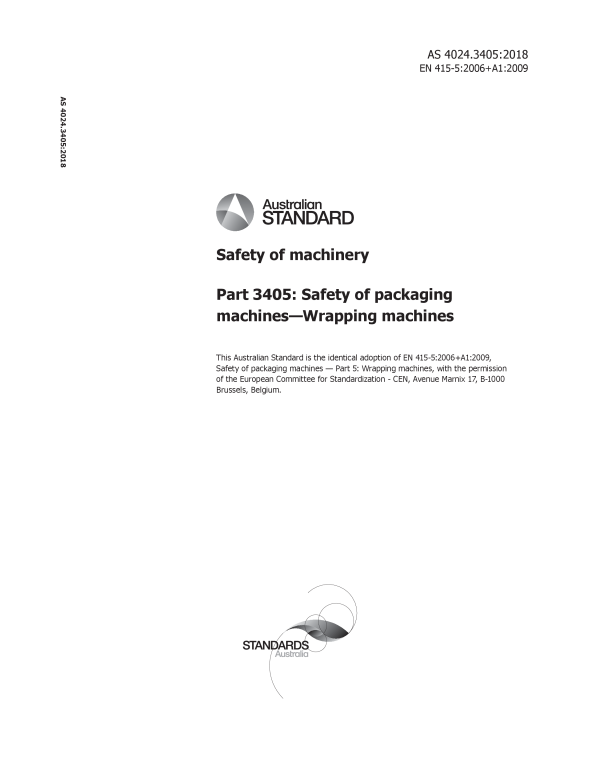

Purchase the full subscription package now and enjoy a 40% discount, along with free updates for future editions.
AS 4024.3405:2018
$296.44
Safety of machinery, Part 3405: Safety of packaging machines — Wrapping machines
The objective of this Standard is to specify safety requirements for machine design, construction, installation, commissioning, operation, adjustment, maintenance and cleaning of wrapping machines.
Table of contents
Header
About this publication
Preface
Foreword
Introduction
1 Scope
2 Normative references
3 Terms and definitions
3.1 Definition of terms
3.2 Description of wrapping machines
4 Hazards on wrapping machines
4.1 General
4.2 General wrapping machine hazards
4.2.1 Mechanical hazards
4.2.1.1 Moving parts
4.2.1.2 Pneumatic and hydraulic equipment
4.2.1.3 Slip, trip and fall hazards
4.2.1.4 Loss of stability
4.2.1.5 Hazards from moveable guards
4.2.2 Electrical hazards
4.2.2.1 Electrical equipment
4.2.2.2 Electrostatic phenomena
4.2.3 Thermal hazards
4.2.4 Noise
4.2.5 Hazards from products and materials
4.2.5.1 Hazards generated by products
4.2.5.2 Hazards generated by packaging materials
4.2.6 Hazards due to neglecting ergonomic principles
4.2.7 Hazards caused by failures
4.2.7.1 Failure of power supplies
4.2.7.2 Failure of safety related parts of control systems
4.2.7.3 Failure of electronic drive systems
4.2.8 Hazards due to neglecting hygienic design principles
4.2.9 Hazards from mechanism used on most wrapping machines
4.2.9.1 Drive systems
4.2.9.2 Belt and slat-band conveyors
4.2.9.3 Roller conveyors
4.2.9.4 Size and product changing
4.2.9.5 Modified atmosphere packaging
4.3 Hazards associated with a banding machine
4.3.1 Product feed
4.3.1.1 General
4.3.1.2 Chains and drives
4.3.1.3 Product pushing or elevating devices
4.3.1.4 In-feed belt conveyors
4.3.1.5 Automatic product feed mechanisms
4.3.2 Handles and hand wheels
4.3.3 Reel unwind mechanism
4.3.3.1 General
4.3.3.2 Film compensator
4.3.3.3 Coders
4.3.3.4 Film reels
4.3.3.5 Powered unwind mechanism
4.3.3.6 Automatic splicing mechanism
4.3.3.7 Electrostatic phenomena
4.3.3.8 Cutting device
4.3.3.9 Sealing devices
4.3.4 Discharge mechanism
4.4 Hazards associated with a sleeve wrapping machine and a stretch banding machine
4.4.1 Product feed
4.4.1.1 General
4.4.1.2 Chain and drives
4.4.1.3 Product pushing or elevating devices
4.4.2 Handles and hand-wheels
4.4.3 Reel unwind mechanism
4.4.3.1 Film compensator
4.4.3.2 Coders
4.4.3.3 Film reels
4.4.3.4 Electrostatic phenomena
4.4.3.5 Cutting device
4.4.4 Tray erecting mechanism
4.4.5 Hot melt adhesive equipment
4.4.6 Discharge mechanism
4.4.7 Shrink tunnel
4.5 Hazards associated with spiral wrapping machines
4.5.1 Product feed
4.5.2 Wrapping head
4.5.3 Product discharge
4.5.4 Ergonomics
4.6 Hazards associated with fold wrapping machines
4.6.1 Product feed
4.6.1.1 General
4.6.1.2 Chains and drives
4.6.1.3 Product pushing devices or pincers
4.6.2 Handles and hand-wheels
4.6.3 Reel unwind mechanisms
4.6.3.1 Film compensator
4.6.3.2 Coders
4.6.3.3 Film reel
4.6.3.4 Powered unwind mechanisms
4.6.3.5 Automatic splicing mechanism
4.6.3.6 Cutting device
4.6.4 Discharge mechanism
4.7 Hazards associated with extruded product wrapping machines
4.7.1 Product feed
4.7.2 Handles and hand-wheels
4.7.3 Reel unwind mechanism
4.7.3.1 Film compensator
4.7.3.2 Coders
4.7.3.3 Film reels
4.7.3.4 Powered unwind mechanism
4.7.3.5 Automatic splicing mechanism
4.7.4 Discharge mechanism
4.8 Hazards associated with twist wrapping machine
4.8.1 Product feed
4.8.1.1 General
4.8.1.2 Feeding belt
4.8.1.3 Product pushing or elevating device
4.8.2 Handles and hand-wheels
4.8.3 Reel unwind mechanism
4.8.3.1 Film compensator
4.8.3.2 Film reels
4.8.3.3 Powered unwind mechanism
4.8.3.4 Automatic splicing mechanism
4.8.3.5 Cutting device
4.8.4 Discharge mechanism
4.9 Hazards associated with over-wrapping machine
4.9.1 Product feed
4.9.1.1 General
4.9.1.2 Chains and drives
4.9.1.3 In-feed belt conveyor
4.9.2 Handles and hand-wheels
4.9.3 Tear tape application group
4.9.4 Reel unwind mechanism
4.9.4.1 Film compensator
4.9.4.2 Coders
4.9.4.3 Film reels
4.9.4.4 Power unwind mechanism
4.9.4.5 Automatic splicing mechanism
4.9.4.6 Electrostatic phenomena
4.9.4.7 Cutting device
4.9.5 Discharge mechanism
4.10 Hazards associated with roll wrapping machines
4.10.1 Product feed
4.10.1.1 Conveyor belt
4.10.1.2 Automatic product feed mechanism (vibration feed)
4.10.2 Handles and hand-wheels
4.10.3 Reel unwind mechanism
4.10.3.1 Film compensator
4.10.3.2 Coders
4.10.3.3 Powered unwind mechanism
4.10.3.4 Automatic splicing mechanism
4.10.3.5 Cutting device
4.10.4 Discharge mechanism
4.11 Hazards associated with foil and band wrapping machines and pleat wrapping machines
4.11.1 Product feed
4.11.1.1 Chain and drives
4.11.1.2 Product pushing and elevating devices
4.11.1.3 In-feed belt conveyors
4.11.2 Handles and hand-wheels
4.11.3 Reel unwind mechanism
4.11.3.1 Film compensator
4.11.3.2 Coders
4.11.3.3 Film reels
4.11.3.4 Electrostatic phenomena
4.11.3.5 Cutting device
4.11.4 Discharge mechanism
4.12 Hazards associated with stretch film wrapping machines
4.12.1 Product feed
4.12.1.1 General
4.12.1.2 Product pushing and elevating device
4.12.2 Reel unwind mechanism
4.12.2.1 Film compensator
4.12.3 Product discharge mechanism
4.13 Hazards associated with L-sealing machine
4.13.1 Semiautomatic machine
4.13.1.1 Product feed
4.13.1.2 L-sealing station
4.13.1.3 Shrink tunnel
4.13.1.4 Stability of the machine
4.13.1.5 Ergonomics
4.13.2 Fully automatic machine
4.13.2.1 In-feed belt conveyor
4.13.2.2 Reel unwind mechanism
4.13.2.3 Electrostatic phenomena
4.13.2.4 Cutting device
4.13.2.5 Shrink tunnel
4.14 Hazards associated with skin packaging machines
4.14.1 Product feed
4.14.2 Product discharge
4.14.3 Stability of the machine
4.14.4 Ergonomics
4.15 Hazards associated with a shrink tunnel and hot water dip tanks
4.15.1 Product transfer system
4.15.2 Thermal hazards
4.15.3 Hazards generated by products
4.15.4 Product discharge
5 Safety requirements for wrapping machines
5.1 General
5.2 General requirements for wrapping machines
5.2.1 Requirement to eliminate mechanical hazards
5.2.1.1 Safeguarding of moving parts
5.2.1.2 Safety by design
5.2.1.3 Fixed and interlocked guards
5.2.1.4 Apertures in guards
5.2.1.4.1 General
5.2.1.4.2 Small apertures
5.2.1.4.3 Medium sized apertures
5.2.1.5 Interlocking devices associated with guards
5.2.1.6 Stopping time
5.2.1.7 Operations with open guards
5.2.1.8 Pneumatic and hydraulic equipment
5.2.1.9 Measures to minimize slip hazards
5.2.1.10 Measures to minimize trip hazards
5.2.1.11 Measures to minimize fall hazards
5.2.1.12 Stability of machines
5.2.1.12.1 Stability during operation
5.2.1.12.2 Stability while being moved
5.2.1.13 Movable guards
5.2.2 Electrical requirements
5.2.2.1 Electrical equipment
5.2.2.2 Supply disconnecting device
5.2.2.3 Excepted circuits
5.2.2.4 Prevention of unexpected start up
5.2.2.5 Protection against electric shock
5.2.2.6 Degree of protection
5.2.2.7 Safety related stop function
5.2.2.8 Emergency stop
5.2.2.9 Electrostatic phenomena
5.2.3 Thermal hazards
5.2.4 Noise reduction
5.2.5 Measures to control hazards generated by products and materials
5.2.5.1 Measures to control hazards generated by products
5.2.5.2 Measures to control hazards generated by packaging materials
5.2.6 Ergonomic design principles
5.2.6.1 Operating the machine
5.2.6.2 Loading packaging materials
5.2.6.3 Loading products or unloading packages
5.2.6.4 Size and product changes
5.2.6.5 Cleaning the machine
5.2.6.6 Maintenance
5.2.6.7 Moving the machine
5.2.7 Requirements to prevent hazards caused by failures
5.2.7.1 Power supplies
5.2.7.2 Requirements for safety related parts of control systems
5.2.7.3 Motor drive system
5.2.8 Hygienic design requirements
5.2.9 Requirements for mechanisms used on most wrapping machines
5.2.9.1 Drive systems
5.2.9.2 Conveyors
5.2.9.2.1 Belt and slat-band conveyors
5.2.9.2.2 Roller conveyors
5.2.9.3 Size and product changing
5.2.9.3.1 General
5.2.9.3.2 Design of guards
5.2.9.3.3 Change parts
5.2.9.3.4 Size or product changing under power
5.2.9.4 Modified atmosphere packaging
5.3 Safety requirements for a banding machine
5.3.1 General
5.3.2 Product feed
5.3.2.1 Chains and drives
5.3.2.2 Product pushing and elevating devices
5.3.2.3 In-feed belt conveyors
5.3.2.4 Automatic product feed mechanism
5.3.3 Handles and hand wheels
5.3.4 Reel unwind mechanism
5.3.4.1 General
5.3.4.2 Film compensator
5.3.4.3 Coders
5.3.4.4 Film reels
5.3.4.5 Powered unwind mechanism
5.3.4.6 Automatic splicing mechanism
5.3.4.7 Electrostatic phenomena
5.3.4.8 Cutting devices
5.3.4.9 Sealing devices
5.3.5 Discharge mechanism
5.4 Safety requirements for a sleeve wrapping machine and a stretch banding machine
5.4.1 General
5.4.2 Product feed
5.4.2.1 In-feed belt conveyor
5.4.2.2 Product pushing or elevating devices
5.4.3 Handles and hand wheels
5.4.4 Reel unwind mechanism
5.4.4.1 Film compensator
5.4.4.2 Coders
5.4.4.3 Electrostatic phenomena
5.4.4.4 Cutting device
5.4.5 Tray erecting mechanism
5.4.6 Hot melt adhesive equipment
5.4.7 Conveyor discharge
5.4.8 Shrink tunnel
5.5 Safety requirements for a spiral wrapping machine
5.5.1 General
5.5.2 Product feed
5.5.3 Wrapping head
5.5.4 Product discharge mechanism
5.5.5 Ergonomics
5.6 Safety requirements for a fold wrapping machine
5.6.1 General
5.6.2 Product feed
5.6.2.1 Chain and drives
5.6.2.2 Product pushing and elevating devices or pincers
5.6.3 Handles and hand wheels
5.6.4 Reel unwind mechanism
5.6.4.1 Film compensator
5.6.4.2 Coders
5.6.4.3 Powered unwind mechanism
5.6.4.4 Automatic splicing mechanism
5.6.4.5 Cutting device
5.6.5 Discharge mechanism
5.7 Safety requirements for an extruded product wrapping machine
5.7.1 General
5.7.2 Product feed
5.7.3 Handles and hand wheels
5.7.4 Reel unwind mechanism
5.7.4.1 Film compensator
5.7.4.2 Coders
5.7.4.3 Film reels
5.7.4.4 Powered unwind mechanism
5.7.4.5 Automatic splicing mechanism
5.7.5 Discharge mechanism
5.8 Safety requirements for a twist wrapping machine
5.8.1 General
5.8.2 Product feed
5.8.2.1 Feeding belt
5.8.2.2 Product pusher
5.8.3 Handles and hand wheels
5.8.4 Reel unwind mechanism
5.8.4.1 Film compensator
5.8.4.2 Powered unwind mechanism
5.8.4.3 Film reels
5.8.4.4 Automatic splicing mechanisms
5.8.4.5 Cutting device
5.8.5 Discharge mechanism
5.8.6 Noise reduction
5.9 Safety requirements for an over-wrapping machine
5.9.1 General
5.9.2 Product feed
5.9.2.1 Chain and drives
5.9.3 Handles and hand wheels
5.9.4 Tear tape application group
5.9.5 Reel unwind mechanism
5.9.5.1 Coders
5.9.5.2 Film reels
5.9.5.3 Power unwind mechanism
5.9.5.4 Automatic splicing mechanism
5.9.5.5 Electrostatic phenomena
5.9.5.6 Cutting device
5.9.6 Discharge mechanism
5.10 Safety requirements for a roll wrapping machine
5.10.1 General
5.10.2 Product feed
5.10.2.1 In-feed belt conveyor
5.10.2.2 Automatic product feed mechanism
5.10.3 Handles and hand wheels
5.10.4 Reel unwind mechanism
5.10.4.1 Film compensator
5.10.4.2 Coders
5.10.4.3 Powered unwind mechanism
5.10.4.4 Automatic splicing mechanism
5.10.4.5 Cutting device
5.10.5 Discharge mechanism
5.11 Safety requirements for a foil and band wrapping and a pleat wrapping machine
5.11.1 General
5.11.2 Product feed
5.11.2.1 Chain and drives
5.11.2.2 Product pushing and elevating devices
5.11.2.3 In-feed belt conveyors
5.11.3 Handles and hand wheels
5.11.4 Reel unwind mechanism
5.11.4.1 Film compensator
5.11.4.2 Coders
5.11.4.3 Film reels
5.11.4.4 Cutting devices
5.11.4.5 Electrostatic phenomena
5.11.5 Discharge mechanism
5.12 Safety requirements for a stretch film wrapping machine
5.12.1 General
5.12.2 Product feed
5.12.3 Product pushing and elevating devices
5.12.4 Reel unwind mechanism
5.12.4.1 Film compensator
5.12.5 Product discharge mechanism
5.12.5.1 Product discharge aperture
5.13 Safety requirements for an L-sealing machine
5.13.1 General
5.13.2 Semiautomatic machine
5.13.2.1 Product feed
5.13.2.2 L-sealing station
5.13.2.3 Shrink tunnel
5.13.2.4 Stability of the machine
5.13.2.5 Ergonomics
5.13.3 Fully automatic machine
5.13.3.1 In-feed belt conveyor
5.13.3.2 Reel unwind mechanism
5.13.3.3 Electrostatic phenomena
5.13.3.4 Cutting device
5.13.3.5 Shrink tunnel
5.14 Safety requirements for a skin packaging machine
5.14.1 General
5.14.2 Product feed
5.14.3 Product discharge mechanism
5.14.4 Stability of the machine
5.14.5 Ergonomics
5.15 Safety requirements for a shrink tunnel and hot water dip tank
5.15.1 General
5.15.2 Product transfer system
5.15.3 Requirement to prevent thermal hazard
5.15.4 Product
5.15.5 Product discharge mechanism
6 Verification of safety requirements and measures
6.1 General
6.2 Visual inspection with machine stopped
6.2.1 Mechanical parts
6.2.2 Pneumatic systems
6.2.3 Hydraulic systems
6.2.4 Electrical systems
6.2.5 Guards
6.2.6 Design requirements
6.3 Measurements with machine stopped
6.3.1 Guards
6.3.2 Electrical testing
6.4 Visual inspections with machine running
6.4.1 Guards
6.4.2 Interlocking devices
6.4.3 Dissipation of stored energy
6.5 Measurements with machine running
6.5.1 Measurement and declaration of noise emission
6.5.2 Temperature
6.6 Verification procedures
7 Information for use
7.1 Marking
7.2 Signals and warning signs
7.3 Instruction handbook
7.3.1 General
7.3.2 Agri-foodstuffs and pharmaceuticals
7.3.3 Machines handling hazardous products
7.3.4 Hot melt adhesive systems
7.3.5 Moveable machines fitted with wheels
7.3.6 Machines incorporating lifting equipment
Annex A
A.1 Scope
A.2 Definitions
A.3 Determination of emission sound pressure level at the workstation
A.4 Sound power level determination
A.5 Installation and mounting conditions
A.6 Operating conditions
A.7 Measurement uncertainties
A.8 Information to be recorded
A.9 Information to be reported
A.10 Declaration and verification of noise emission values
Annex B
B.1 Interlocked guard
B.2 Interlocked guard with ESPE trip device
B.3 ESPE trip device
B.4 Automatic guard
Annex C
Annex ZA
Annex ZB
Bibliography
Cited references in this standard
Content history
EN 415-5:2006+A1:2009
DR AS EN 4024.3405:2017
Please select a variation to view its description.
| Published | 03/05/2018 |
|---|---|
| Pages | 96 |
Please select a variation to view its pdf.
